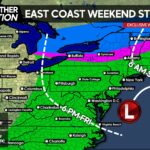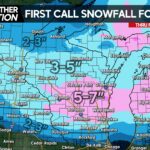We are now less than two months from the start of fall foliage and three months away from first flakes across much of the state. While it’s too early to release forecast maps, it’s the prime time to look at driving factors of the upcoming winter. The most important factor of course being the ENSO (El Nino/La Nina) will be in a very weak La Nina phase. This is important because last winter we saw one of the strongest El Nino events in history. As we all know, the winter wasn’t pretty for snow lovers especially in Northern Pennsylvania. However, this year we will see a very weak La Nina and possibly even a neutral phase. Just how do we know this already?
The image above displays a plume of models predicting the ENSO. The majority of models indicate a neutral or very weak La Nina phase. Furthermore, several of the more respectable models such as the ECMWF (Euro), and the JAMSTEC predict we will only see a neutral to Weak La Nina phase. How will that impact our weather? For the best answer to that question, we look at analogs. Our job is to pick out the most similar ENSO years to the current one, and examine what occurred those winters. We do this because what occurred in analog winters could be very similar to what occurs this winter.
We selected five winters with very similar ENSO conditions as this year. We then generated a map of temperatures compared to normal during the selected winters. But what if we go into a weak to moderate La Nina phase instead of neutral to very weak? We also chose analog winters where a weak to moderate La Nina developed. Below are the two maps.
The map on the left shows what played out during the neutral to very weak La Nina winters. Below normal temperatures were seen across the entire Eastern US, including Pennsylvania. The map on the right shows what played out temperature-wise in Weak to Moderate La Nina winters. Near normal temperatures were seen throughout our area. As stated, we will likely be looking at a neutral or very weak La Nina phase. Below is one of the best models, the JAMSTEC, predicting sea surface temperatures this winter.
With La Nina very weak, the door will be opened for others factors such as the PDO (which is driven somewhat by the ENSO) to take control. A strengthened PDO usually translates to ridging in the Western US, meaning troughing in the east. This is yet another factor that will have an impact on our winter. But do these potential below average temperatures implicated by the analogs as well as models mean above average snowfall? We gathered the snowfall totals from our top five analog winters for four Pennsylvania cities and compressed all of the data into a graphic shown below.
Four out of our five analog winters brought above average snowfall to all four selected Pennsylvania cities. Only one winter ended below normal in the snowfall category. While we are not using these numbers as official predictions in any way, they will likely impact our preliminary winter outlook coming in October.
To sum it all up, analogs of this upcoming winter were on the cold and snowier side. This is not a forecast though, just yet. Be sure to share this article below and don’t forget to like Pennsylvania Weather Action on facebook if you haven’t yet by clicking here! Stay tuned everyone!







You must be logged in to post a comment.